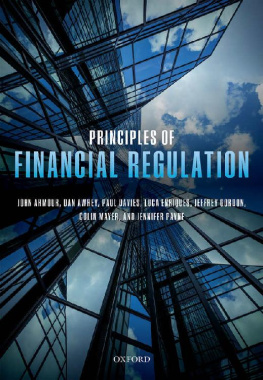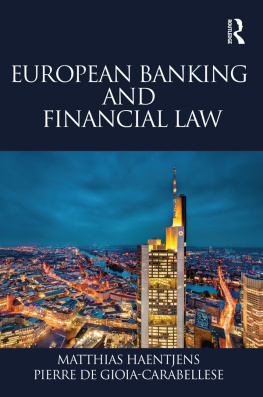CITIZENS FINANCIAL FUTURES
Citizens Financial Futures
The regulation of retail investment financial services in Britain
MICHAEL CLARKE
University of Liverpool
First published 1999 by Ashgate Publishing
Reissued 2018 by Routledge
2 Park Square, Milton Park, Abingdon, Oxon OX14 4RN
711 Third Avenue, New York, NY 10017, USA
Routledge is an imprint of the Taylor & Francis Group, an informa business
Copyright M. Clarke 1999
All rights reserved. No part of this book may be reprinted or reproduced or utilised in any form or by any electronic, mechanical, or other means, now known or hereafter invented, including photocopying and recording, or in any information storage or retrieval system, without permission in writing from the publishers.
Notice:
Product or corporate names may be trademarks or registered trademarks, and are used only for identification and explanation without intent to infringe.
Publishers Note
The publisher has gone to great lengths to ensure the quality of this reprint but points out that some imperfections in the original copies may be apparent.
Disclaimer
The publisher has made every effort to trace copyright holders and welcomes correspondence from those they have been unable to contact.
A Library of Congress record exists under LC control number: 98070152
ISBN 13: 978-1-138-61358-4 (hbk)
ISBN 13: 978-1-138-61360-7 (pbk)
ISBN 13: 978-0-429-46377-8 (ebk)
Contents
My interest in financial services regulation grew out of earlier work on the period leading up to the Financial Services Act 1986 (Clarke, 1986), and more recently work on the regulation of estate agency conducted at the time when large financial firms were buying up huge chains of estate agents (Clarke et al., 1994). I made several efforts to raise money for field research into the habits and capacities of investors and their interaction with sellers of investment products, in the light of the substantial absence of anything approaching systematic information on this side of the equation, as opposed to the regulatory and industry side. Such research still, in my view, needs to be undertaken, though five years monitoring the development of regulation and the response of the industry permits fairly firm conclusions to be drawn.
In the course of my inquiries a wide variety of people in the financial services industry, among regulators, the press and among investors have been generous in their assistance, in providing information and giving interviews. To identify individuals would be invidious, but I am grateful to them all.
The University of Liverpool and the Department of Sociology allowed me a semesters leave in 1995 to begin putting the material for this book together. My thoughts were sharpened by preparing some of it as a paper for a conference on European Management and Organisations in Transition in 1996 at the invitation of Glenn Morgan. Versions of some of the chapters were also presented at seminars at the University of Warwick, School of Law, the Regulatory Policy Research Centre, University of Oxford, and the Northern Organisational Research Conference, John Moores University.
The typescript was diligently typed by Sue Adebanjo and the camera-ready copy prepared by Pat FitzGerald, to whom as well as to Lorraine Campbell I am grateful for their expertise.
Finally, I am grateful to Liz Kingdom for commenting on the draft and for her interest and encouragement throughout. Needless to say the judgements and errors remain my responsibility.
Michael Clarke
Liverpool
October 1997
The difficulties that currently beset the current financial services industry, particularly in respect of longer term savings and investment products such as life assurance, pensions and mortgages have their origins in success. It is the enormous expansion of the financial services sector as a whole in the postwar years on the back of the rise of affluence in the middle classes that has created the political and economic context in which mass participation in personal savings and investments has become so fraught a matter. This chapter will identify that growth and go on to elaborate the context by including the rise of consumerism and the success of the welfare state as crucial additional factors. The fundamental thesis will be that the financial security traditionally associated with middle class status has recently been put in question by multiple shocks: unemployment, job insecurity, a dangerously volatile housing market, rising rates of family breakdown and the fiscal crisis of the state. The outcome is a state led expectation of increasing participation in financial services by individuals in order to secure themselves. The unresolved questions concern the terms on which they may be expected to do this. It is these terms which regulation since the mid 1980s has attempted to set with, as the following chapters will show, only limited success. We should be wrong to overemphasize the present and its failings. As stated above the current difficulties, severe though they are, are the outcomes of substantial successes.
The Rise of Affluence and of the Middle Classes
Such is the concern with international competition today that the more or less sustained pattern of postwar economic growth averaging 2.4 per cent per annum is frequently ignored. Whilst Britain became less affluent than its reference nations in the early postwar years the USA then France, Germany and Japan and more recently the Asian Tiger economies sustained growth has produced a social and economic transformation.
The occupational class structure has shifted progressively towards white collar work, with its traditionally better working conditions, fringe benefits, including occupational pension schemes, job security and promotion prospects. Whilst expansion has been greater in terms of numbers in the lower white collar occupations which have come to sustain weaker career development prospects as they have expanded, the fastest and most sustained growth has been in the upper sectors. The following tables show the process of transformation. The allocation of occupations to agreed social classes is now a professional expertise in its own right, the details of which are beyond the scope of this chapter. Regrettably the outcome is that it is difficult to obtain full time series before academic research has taken place. hence abuts Rouths comparison of the 1951 and the 1981 figures with the Registrar Generals classifications in the last two national censuses. The figures differ but the trend is confirmed.
* At factor cost This measure of GDP excludes taxes on expenditure and subsidies.
Source: Office for National Statistics.
It is not simply the rise of the middle classes to constitute nearly half the population that is significant however, but the spread of affluence more widely. By the mid-1950s the identification of affluent workers in modern industries such as vehicles, aircraft, chemicals and light engineering began to generate increasing debate. First it was pointed out that these workers were earning as much or even more than those in white collar jobs, albeit sometimes because of consistently available overtime. Further, it was recognized, not least by those industries ready to offer products and services for these workers additional income, that a shift in consumption patterns and lifestyle was taking place, which affected not only the expanding middle classes but the affluent working classes too. At a lower level the spread of household appliances and fittings vacuum cleaners, washing machines, refrigerators, freezers, food processors, telephones, televisions and fitted carpets was progressive to the point where, for example, only the exceptional family in the 1950s would have had a television where in the 1990s a family reliant on state benefit would expect to have one, and of course a much larger one with colour reception. At the more substantial end of expenditure affluence was manifested in the growth of home and car ownership and the rise of foreign holidays, assisted by the creation of the package holiday. Although Thomas Cook is generally credited with founding the foreign tour industry in 1841 the true package holiday was dependent on the modern passenger jet aircraft. The first package holiday was put together by the founder of Horizon Holidays in 1950. Civil Aviation Authority figures indicate a rise in package holidays to 2.7m in 1970,6.25m in 1980 and 12.0m in 1990. The International Passenger Survey for the Office of National Statistics gives the following picture for recent years.











